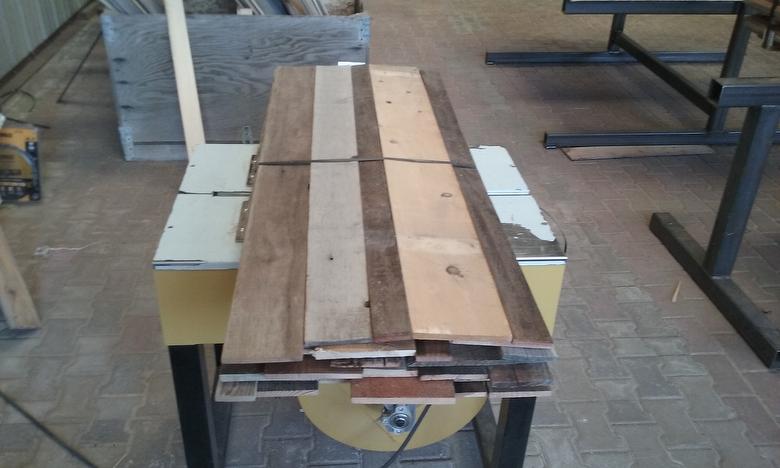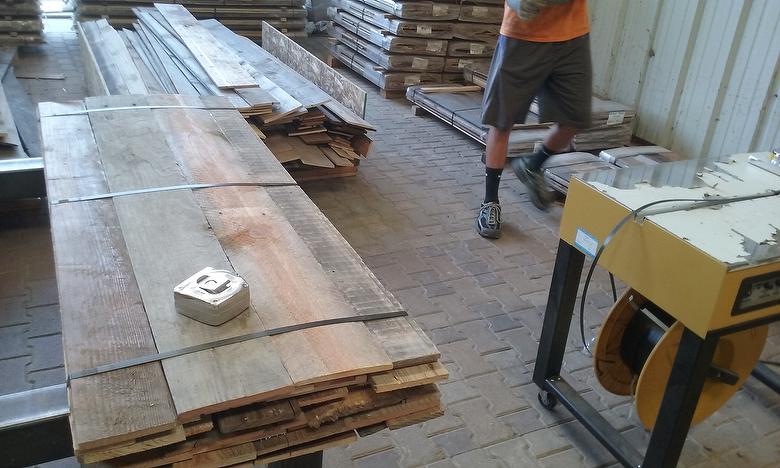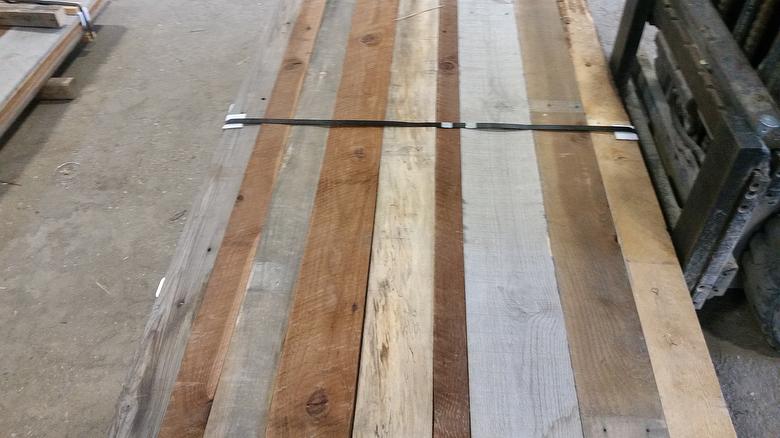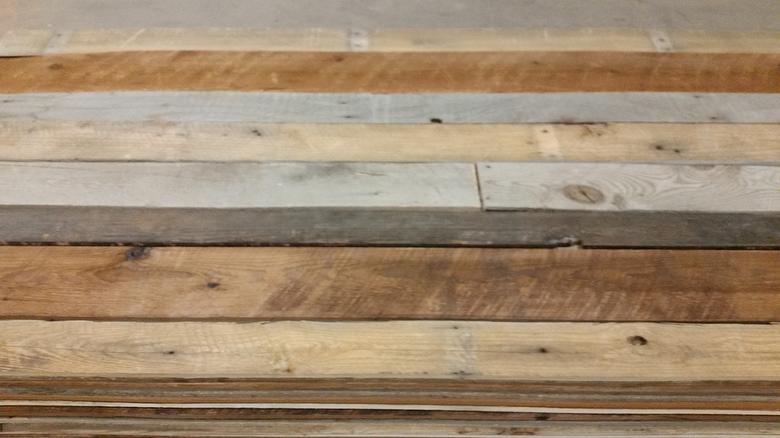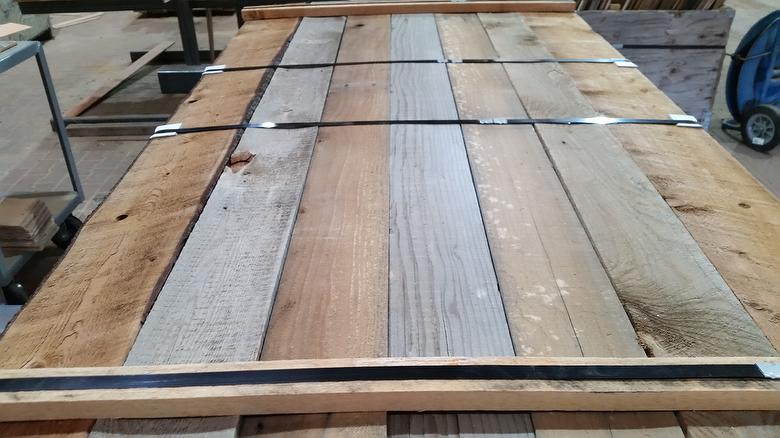WeatheredBlend Thin Skins (50 sf unit)
WeatheredBlend Thin Skins (50 sf unit)
each unit contains 50 square feet of product
Specification Sheet #7241 - WeatheredBlend Skins
Height
Width
Length
Quantity
Rand 1/4- 1/2"
Rand 2-8"
Rand to 7'
min: 1 unit
List Price: $200.00 per unit
Online Price:$180.00 per unit
Request Quote Instead
(large quantities, any customization, etc.)
Height
Width
Length
Quantity
Rand 1/4- 1/2"
Rand 2-8"
Rand to 7'
min: 1 unit
Related Productline Pages
WeatheredBlend Thin Skins
Specification Sheet #7241 - WeatheredBlend Skins
Products Involved
Trestlewood's WeatheredBlend Skins involve a mix/blend of various sources of reclaimed/antique material and materials naturally aged/processed to give them a weathered/aged appearance. Trestlewood products that can be included in a WeatheredBlend Skins package include, but are not necessarily limited to, any combination of skins generated from NatureAged Lumber (Specification Sheet #7220), skins generated from Antique Barnwood Lumber (Spec Sheet #7200), skins generated from HarborAged Lumber (Spec Sheet #2240), skins generated from ThermalAged Lumber (Spec Sheet #7230), skins generated from RubyHardwood Lumber (Spec Sheet #6147), 3/8"+/- Weathered Pine Jackets (Spec Sheet #3242), 3/8"+/- Weathered Picklewood/Other Jackets (Spec Sheet #2241), skins generated from Trestlewood II Lumber (Spec Sheet #1202), and skins generated from various other sources. Blended products are results oriented - they increase Trestlewood's ability to economically achieve a look desired by a client by freeing up the strengths and inventory of multiple complementary product lines.
Species
Mixed, generally heavy to (and often exclusively) softwoods. Hardwoods can be included in the mix at Trestlewood's discretion. Hardwood skins are sometimes available (generally at higher cost).
Source
NatureAged: Material that has been naturally weathered/aged/processed to achieve a rustic grayish/brown appearance. Lumber used in Trestlewood's NatureAged Lumber program can be i) new lumber, ii) lumber cut from beetle-killed, fire-killed or dead-standing trees, iii) lumber cut from material which has weathered out of spec, and/or iv) lumber cut from lumber/timber reclaimed from various salvage projects/prior uses (this lumber also qualifies as Antique Barnwood Lumber.)
Reclaimed/Antique: Reclaimed sources include barns, corncribs, stables, trestles, mills, homes and other buildings/agricultural structures and construction projects from different locations in North America. Picklewood comes from pickle vats salvaged from different sites in North America. Trestlewood II comes from Douglas Fir piling salvaged from the Lucin Cutoff railroad trestle in the Great Salt Lake.
Other: HarborAged Lumber, ThermalAged Lumber, RubyHardwood Lumber, etc (see individual spec sheets.)
Reclaimed/Antique: Reclaimed sources include barns, corncribs, stables, trestles, mills, homes and other buildings/agricultural structures and construction projects from different locations in North America. Picklewood comes from pickle vats salvaged from different sites in North America. Trestlewood II comes from Douglas Fir piling salvaged from the Lucin Cutoff railroad trestle in the Great Salt Lake.
Other: HarborAged Lumber, ThermalAged Lumber, RubyHardwood Lumber, etc (see individual spec sheets.)
Knots
Unlimited; occasional loose or fallen out knots
Checking/Cracks
Unlimited. The number of checks coupled with the thin nature of this product will result in some pieces splitting unless great care is taken when handling.
Grain Pattern
Mixed
Moisture Content/Stability
Air-Dried. Thin lumber products like WeatheredBlend Skins are going to have some stability issues (cupping, twisting, etc.) Focusing on narrow widths and shorter lengths can help to reduce such issues.
Standard Dimensions
a) Thickness: approximately 3/8" (+/- 1/8"); b) Width (nominal): random 2"-8"; and c) Length: 1' increments up to 7'. Skins wider than 8" and longer than 7' can be included in the mix at Trestlewood's discretion. Trestlewood's focus is on narrower and shorter boards to reduce stability issues. Where skins are supplied in wider widths and longer lengths, Buyer may want to consider cutting them down. Much of Trestlewood's hardwood skins are 4' and under.
Weight
Typically, approximately 1.25-1.50 pounds per square foot.
Surfacing
WeatheredBlend Skins includes a wide range of surfacing/textures. NatureAged Lumber is generally originally rough-sawn (circle-sawn or band-sawn), but may have weathered rather smooth. Antique Barnwood and other sources can be rough-sawn or smooth. Degree of weathering varies from source to source. Antique Barnwood is often more deeply weathered than NatureAged Lumber.
WeatheredBlend Skins colors can also vary widely. Common colors include browns, light browns, grays, light grays and
combinations of browns and grays. Many boards have a mix of colors. Some boards may have striping as a result of variations in weathering from being attached to other material during use. Trestlewood can sometimes sort for a heavy-to-brown or heavy-to-gray color range (typically at an additional cost), but generally does not offer a color sort which does not allow for some latitude in color provided. NatureAged Lumber generally is more consistent in color and other characteristics than is Antique Barnwood.
WeatheredBlend Skins will generally have 1 fresh-sawn (or less heavily weathered) face and can have 1 or 2 fresh-sawn edges (i.e., the focus is on producing a product with 1 weathered "primary" face).
WeatheredBlend Skins colors can also vary widely. Common colors include browns, light browns, grays, light grays and
combinations of browns and grays. Many boards have a mix of colors. Some boards may have striping as a result of variations in weathering from being attached to other material during use. Trestlewood can sometimes sort for a heavy-to-brown or heavy-to-gray color range (typically at an additional cost), but generally does not offer a color sort which does not allow for some latitude in color provided. NatureAged Lumber generally is more consistent in color and other characteristics than is Antique Barnwood.
WeatheredBlend Skins will generally have 1 fresh-sawn (or less heavily weathered) face and can have 1 or 2 fresh-sawn edges (i.e., the focus is on producing a product with 1 weathered "primary" face).
Salt/Minerals
Trestlewood II and Picklewood materials contain significant amounts of salt and other minerals, creating special characteristics and/or considerations such as color/appearance, finishes/glues, metal corrosiveness, moisture, etc. (see Trestlewood II Specification Sheet #1202 and Picklewood Specification Sheet #2241 for more information).
Appearance Variation
Boards can vary in appearance from piece to piece and even within a piece. The characteristics described on this specification sheet generally apply to each board's featured face. The opposite face and edges can differ from the featured face in texture, coloring, and other characteristics unless otherwise noted. Weathered lumber / barnwood will have at least one weathered face. The opposite face and edges can be any combination of weathered and fresh-sawn. If weathered, the weathering will often be different (amount, mix of colors, etc) than on the featured face.
Trestlewood sometimes uses one or more juicing processes to help fresh-sawn and/or less weathered/aged faces/edges blend in with weathered faces/edges. All else being equal, juicing is more likely to be used in situations where (a) lumber is cut from timbers or wider lumber (thereby creating fresh-cut faces and/or edges); (b) Buyer wants all (or most) faces/edges to be weathered/aged; (c) Buyer desires to increase the consistency of the weathered/aged look from face to face; and/or (d) Buyer wants a darker weathered look.
Trestlewood sometimes uses one or more juicing processes to help fresh-sawn and/or less weathered/aged faces/edges blend in with weathered faces/edges. All else being equal, juicing is more likely to be used in situations where (a) lumber is cut from timbers or wider lumber (thereby creating fresh-cut faces and/or edges); (b) Buyer wants all (or most) faces/edges to be weathered/aged; (c) Buyer desires to increase the consistency of the weathered/aged look from face to face; and/or (d) Buyer wants a darker weathered look.
Other
WeatheredBlend Skins can be very brittle and may split easily. Special care, such as pre-drilling holes for nails, is advisable.





